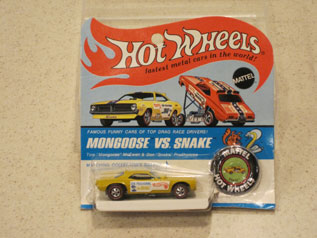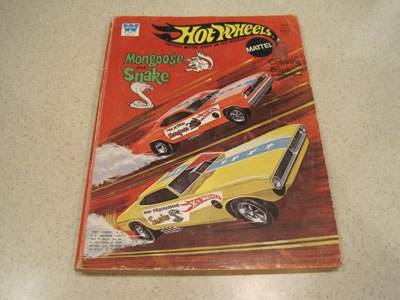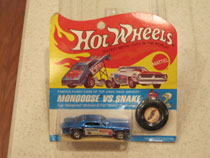

'Snake' and 'Mongoose' collection
Y'know, I thought I was one of the biggest "Snake" and "Mongoose" fans in the world, but Jeff Mittendorf has me and just about the rest of you beat like the Army Monza did the world in 1975-76. I was the lucky guy who grew up playing with the Hot Wheels cars of Don Prudhomme and Tom McEwen and today can pick up the phone and call either of them on a whim, but my collection of stuff pales in comparison to what Mittendorf shared with me recently. I find it interesting to see what kind of effort Mattel put into the line in addition to the commercials I showed here previously.
Check out some of his collection. Click on any of the images for a bigger version.
 |
 |
Here are genuine factory-sealed 1970 "Snake" and "Mongoose" "redline tire" cars and collector buttons still in their original blister packs. I found similar ones on sale on the web for as much as $400 each.
 |
Here's the Club Kit magazine you got when you joined the Hot Wheels Club. According to Mittendorf, you received a box with a special chrome-plated car (King Kuda, Heavy Chevy, or Boss Hoss), a patch, stickers, membership card, and this catalog that featured "the Snake" and "the Mongoose" on the cover (left) and the dragstrip track set inside (right). I have a chrome Heavy Chevy in my collection, but I don’t recall getting it by joining the club. I think I mailed away for it somehow.
 |
At right is the "Mongoose" and "Snake" coloring book. I find it interesting that McEwen gets top billing here because you most often hear people say
" 'Snake' and 'Mongoose.' " Other than the slightly chopped tops, it's a pretty cool drawing of the old rivals racing each other.
According to Mittendorf, the book is about 50 pages and tells a story about two kids who do chores to save money for Hot Wheels.
"On their way home from the toy store, they see a billboard promoting a local drag race," he continued. "When they get home, they play Hot Wheels with their dads. The next day, the dads surprise the kids with tickets to the race. At the race, the kids meet 'Snake' and 'Mongoose' in the pits. After the race, the kids win a raffle for a 'Snake' and 'Mongoose' drag set, which they then play upon returning home." Lucky kids!
 |
 |
Above left is an interesting ad that Mittendorf said appeared on the back of the October 1970 Archie & Me comic book (and probably several others) promoting the "Mongoose"/"Snake" dragstrip kit, "a realistic recreation of the coast-to-coast racing struggle between the two champs." The more I think about the whole "Mongoose-first" thing, it dawns on me that maybe because it was McEwen and his contacts (through his stepfather, Joe Ball, an attorney whose company counted Mattel among its clients, McEwen got the name of company vice president Art Spears) that launched the history-making deal, maybe he got first billing. Mittendorf also pointed out that for some reason "the Mongoose's" car is depicted as McEwen's red-white-blue '69 Barracuda Funny Car and not the red Hot Wheels '70 Duster. Weird.
Above right is an awesome ad that ran in several car magazines in 1970 with the tagline "Don Prudhomme says it tears even better than his" that plays on the fact that the Hot Wheels cars could hit a scale speed of 440 mph. There's a pretty cool time-to-distance/time-to-speed graph and some specs about the Hot Wheels diecast (including curb weight: 42.5 grams; wheelbase: 1.860 inches; width: 1.16 inches; ground clearance: .03-inch; and many more). I've made the "bigger" image of this, well, bigger so you can read the details.
 |
Such a deal. For 70 cents and a six-pack of Coca-Cola, you could have had your own "Mongoose" or "Snake" (see, I learn fast) Hot Wheels car. Given the price today, that would be a pretty shrewd investment. "I'm curious if any readers bought some this way, how they were packaged (blister pack, baggie, loose), and if they came with the buttons," said Mittendorf. Anyone?
 |
The 72-car storage/carrying case featuring our two heroes on the front. There are two different versions here, with a text color change on the front chin spoilers. My guess is that the one on the right, with the red lettering, was either a mistake or the designer realized they were hard to read and changed it to black somewhere in the run. (Sorry, there's no "bigger" photo of this one.)
 |
 |
 |
Here's the 1971 model offerings, including the Snake II and Mongoose II Funny Cars and their short-lived front-engine cars that worked in the Wild Wheelie set. The art on the Dragster Pak is pretty cool, Make sure you click on the small image here to see the bigger version. According to Mittendorf, the dragsters were only available in the Wild Wheelie set or on the two-pack and were not available individually. Note also that the track pieces that make the dragsters come out of their wheelie position are under the cars. Smart thinking!
 |
 |
Above are the wedge dragsters in blister packs. "These are not mine since, as you recently noted, they aren't legit," said Mittendorf. "I only collect the toys/memorabilia related to the real cars, but I thought I should include these since they are relevant to the topic." What makes them "not legit" is that Prudhomme's Hot Wheels wedge was red and McEwen never had one.
 |
 |
 |
Here's one of Mittendorf's prize possessions, an original 1972 press kit, signed by both. "This is extremely rare," he noted. "I've only seen a couple." You can buy a duplicate of the kit online for about $100, but the originals, according to The Toy Peddler website, "cost a fortune." The front of the press kit holds two cars in blister packs ("The cars included were leftover 1971 Funny Cars, as Hot Wheels became an associate sponsor for 1972 and didn't produce the Carefree Gum cars," said Mittendorf). There's some cool art on the back (above center) and a black-and-white photo of the famous duo holding 1/24th-scale Monogram models of their front-engine dragsters.
Below are the inside of the kit, with more cool line drawings, and Mittendorf even has the original press releases that came inside, containing info about Prudhomme and McEwen and drag racing in general.
 |
 |
 |
I bet you never knew that Tom McEwen drove a Barracuda Funny Car. Well, of course, he never drove a Hot Wheels 'Cuda; this is the result of cost-cutting by Mattel in 1973. According to Mittendorf, "In an effort to cut costs, they made both the 'Snake' and 'Mongoose' cars out of 'Cudas and scrapped the Duster. No body prop or windows were included, and the chassis was now a one-piece casting instead of a multi-piece assembly. There was no special 'Snake' and 'Mongoose' blister artwork. They also released all four of the previous colors at once (white and yellow 'Snake', red and blue 'Mongoose'), but the shades were slightly different. The paint is also not as high quality as before and chipped/peeled much easier than the previous versions, especially the red 'Mongoose.' "
 |
 |
Only Snake II and Mongoose II stickers were used, so in addition to the Mongoose II being a 'Cuda, the yellow Snake II had incorrect blue artwork, as shown at left. Production numbers were way down, so the 1973 "Snake" and "Mongoose" cars are easily the most valuable of the "Snake" and "Mongoose" Hot Wheels. At right is another of Mittendorf's prized possessions, a 1970 "Mongoose" car on the 1973 blister card. "There are only three of these known to exist in the Hot Wheels community," he stated. "There must have been some leftover red "Mongoose" Dusters in the factory, and when the 1973 cards came out specifically labeled for "the Mongoose," someone must have seen an opportunity to get rid of unwanted/obsolete stock. There is no sticker sheet under the car, just the one on the passenger side of the car, as was the manufacturing procedure in 1970-71. To my knowledge, there aren't any yellow 1970 Snakes, white 1971 Snakes, or blue 1971 Mongooses on 1973 cards (if there are, I'd love to see/find it). There are a couple of other castings from previous years known to have appeared on the 1973 card. They are easy to spot as they were painted in spectraflame colors, whereas the 1973 cars were all solid enamel colors."
OK, that's enough for today. I've got a few other things from his collection to show you later this week and still more ramp truck madness!



















































